Rechercher dans ce blog
Wednesday, June 30, 2021
Watch thousands of fire ants form living 'conveyor belts' to escape floods (Video) - Livescience.com
It takes a lot of teamwork to survive floods, and fire ants cooperate in the tens of thousands to build rafts of their bodies to float until the water subsides. Now, a time-lapse video shows how these crafty insects also create living conveyor belts on these rafts to help the riders reach dry land.
The footage revealed how ant rafts changed their shape, with slender extensions of ants growing from the main sections of ant rafts like tentacles, over just a few hours. These bridges grew from the combined activity of two ant groups: so-called structural ants — insects that pack closely together to keep the colony afloat — that circulated to the top of the pile from the bottom, and surface ants that marched freely about on top of the rafts, which then moved into supporting positions underneath their friends and relatives.
Related: Image gallery: Ants of the world
There are more than 20 species of fire ants worldwide, but one species in particular, the red imported fire ant (Solenopsis invicta), is known for its massive colonies of as many as 300,000 workers, according to North Carolina State University.
If their underground tunnels flood, fire ants link together to create floating rafts that can hold together for weeks, if necessary, carrying the colony until waters recede. A fire ant's exoskeleton naturally repels water, and its rough texture traps air bubbles. Tightly knit ant bodies can, therefore, create a buoyant, water-resistant foundation for a floating raft, Live Science previously reported.
Vast fire-ant rafts were numerous in southern Texas in the wake of 2017's record-breaking Hurricane Harvey. People who were also fleeing the storm's floodwaters were advised to steer clear of the rafts, as fire ants' venomous bites are extremely painful, Live Science reported that year.
Prior research found that even after an ant raft's structure stabilized, its shape continued to change, with questing tentacles extending in multiple directions — but scientists didn't know how, exactly, that was happening.
"These protrusions have, to our knowledge, neither been documented nor explained in the existing literature," researchers wrote in a new study, published June 30 in the Journal of the Royal Society Interface.

They collected around 3,000 to 10,000 fire ants at a time and deposited the insects in containers of water with a rod in the center, around which the ants congregated and formed rafts. The scientists then filmed the ant rafts, capturing time-lapse and real-time footage of raft formation and shape changing. Image-tracking data and computer modeling revealed which parts of the ant raft were static and which parts were moving — and where all of the ants in the raft's different layers were going.
The study authors found that the raft's exploratory tentacles were shaped by ant movement that the study authors called "treadmilling." As structural ants wriggled to the surface of the raft, free-walking ants would burrow into the lower structural levels. Together, this cycle contracted and expanded the raft, crafting narrow bridges of ants reaching outward to search for land nearby where the colony could safely disperse.
Other factors — such as the season, time of day and the colony's habitat — can influence ant behavior and could also play a role in the dynamics that shape fire ants' rafts. Those variables weren't explored in the experiments, but they could be investigated in future studies, the scientists concluded.
Originally published on Live Science.
Article From & Read More ( Watch thousands of fire ants form living 'conveyor belts' to escape floods (Video) - Livescience.com )https://ift.tt/3hoVfOk
Science
SpaceX just launched 88 satellites to space - The Verge
Dozens of satellites launched to space on Tuesday in SpaceX’s second in-house “ride-share” mission from Florida, bringing the total number of orbital objects carried by Elon Musk’s space company this year to nearly 900. A reused Falcon 9 rocket launched 88 satellites total for the “Transporter-2” mission, including the first five for a new Pentagon agency and dozens more for various companies, countries, and schools.
SpaceX’s Falcon 9 rocket lifted off at 3:31PM ET from Cape Canaveral, Florida, marking the company’s 20th launch this year and the eighth flight for the rocket’s first stage booster. That booster returned to Earth about 10 minutes later at SpaceX’s Landing Zone 1, a pad of concrete that hasn’t been used for rocket landings since December; Falcon 9 boosters usually land on sea-faring drone ships.

Meanwhile, the carpool of 88 satellites was pushed toward a sun-synchronous, pole-to-pole Earth orbit by Falcon 9’s second-stage booster. Thirty-six tiny satellites were mounted on a new payload adapter built by Spaceflight, a company that books space for small satellites on rockets, alongside other satellites arranged by SpaceX.
This was mission number two for SpaceX’s cost-cutting SmallSat Rideshare Program, which offers tiny satellites rides to space for a starting price of $1 million. Cheaper launch services in the space industry have reinvigorated a market for simple shoebox-sized satellites that have long been forced to hitch rides on larger missions. SpaceX’s ride-share program taps into that growing small satellite market, where companies can offer services ranging from communications to Earth observation.
The Pentagon’s Space Development Agency (SDA) had five satellites aboard Transporter-2 that will test laser communications between one another in space as well as a separate experiment designed to test in-space data processing (a method that takes time-consuming ground terminals out of the equation). Those two tests support the agency’s goal of eventually communicating with ships and weapons systems faster than ever before. The SDA has two tranches of satellite networks slated to launch in the next few years.
Other objects on board included a cluster of satellites from geospatial analytics firm HawkEye 360 that will gather radio frequency data and another cluster from radio frequency reconnaissance firm Kleos that will “detect and geolocate maritime radio frequency transmissions” for commercial and government customers. Two nano-satellites from Tyvak, a satellite firm that offers governments optical and remote-sensing services from space, are also on board, though the company declined to say for which agency the satellites will be used.
:no_upscale()/cdn.vox-cdn.com/uploads/chorus_asset/file/22692109/P6110410.jpeg)
The Transporter-2 mission ups the total number of satellites launched by SpaceX since late January to nearly 900 — almost double what the entire world launched in any single year before 2020. The vast majority of those satellites are for SpaceX’s Starlink internet network that’s poised to continue growing throughout the year.
SpaceX first tried launching Transporter-2 on Tuesday but stopped the countdown clock 11 seconds before liftoff and postponed until Wednesday because a private helicopter entered airspace that was closed off by the Federal Aviation Administration for the mission. Musk called the FAA’s keep-out zone for pilots “unreasonably gigantic” in a tweet and blasted the agency’s regulations as “broken,” bluntly echoing the same long-held grievances from other space companies and lawmakers who see the FAA’s airspace rules as outdated and inefficient.
The president of the Air Line Pilots Association sided with Musk’s tweet, saying, “We agree that there is a better way and stand ready to work with [SpaceX, FAA], and others to support the safe integration of all national airspace users.” Lawmakers pressed the FAA’s space chief Wayne Monteith on the issue last month during a hearing. He said a new updated system managed by the FAA’s Air Traffic Organization chief operating officer should be ready for operational tests “in the next few months,” following years of development.
Article From & Read More ( SpaceX just launched 88 satellites to space - The Verge )https://ift.tt/3637yuj
Science
A white dwarf living on the edge - Phys.org
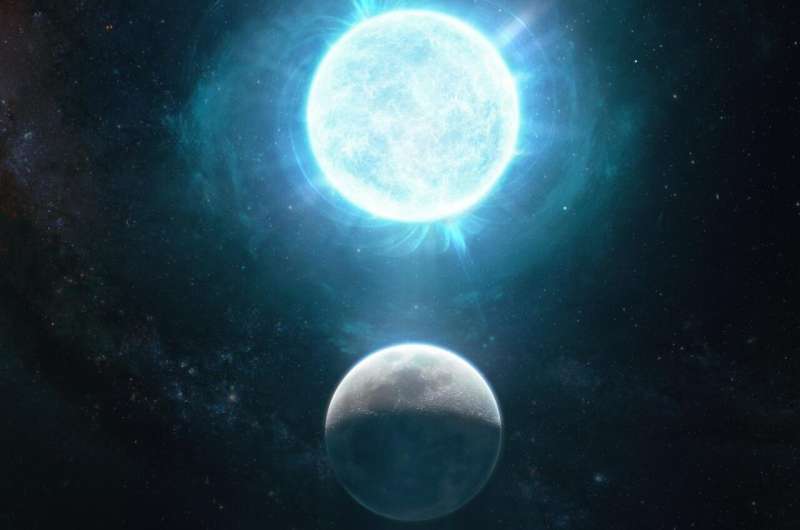
Astronomers have discovered the smallest and most massive white dwarf ever seen. The smoldering cinder, which formed when two less massive white dwarfs merged, is heavy, "packing a mass greater than that of our Sun into a body about the size of our Moon," says Ilaria Caiazzo, the Sherman Fairchild Postdoctoral Scholar Research Associate in Theoretical Astrophysics at Caltech and lead author of the new study appearing in the July 1 issue of the journal Nature. "It may seem counterintuitive, but smaller white dwarfs happen to be more massive. This is due to the fact that white dwarfs lack the nuclear burning that keep up normal stars against their own self gravity, and their size is instead regulated by quantum mechanics."
The discovery was made by the Zwicky Transient Facility, or ZTF, which operates at Caltech's Palomar Observatory; two Hawai'i telescopes—W. M. Keck Observatory on Maunakea, Hawai'i Island and University of Hawai'i Institute for Astronomy's Pan-STARRS (Panoramic Survey Telescope and Rapid Response System) on Haleakala, Maui—helped characterize the dead star, along with the 200-inch Hale Telescope at Palomar, the European Gaia space observatory, and NASA's Neil Gehrels Swift Observatory.
White dwarfs are the collapsed remnants of stars that were once about eight times the mass of our Sun or lighter. Our Sun, for example, after it first puffs up into a red giant in about 5 billion years, will ultimately slough off its outer layers and shrink down into a compact white dwarf. About 97 percent of all stars become white dwarfs.
While our Sun is alone in space without a stellar partner, many stars orbit around each other in pairs. The stars grow old together, and if they are both less than eight solar-masses, they will both evolve into white dwarfs.
The new discovery provides an example of what can happen after this phase. The pair of white dwarfs, which spiral around each other, lose energy in the form of gravitational waves and ultimately merge. If the dead stars are massive enough, they explode in what is called a type Ia supernova. But if they are below a certain mass threshold, they combine together into a new white dwarf that is heavier than either progenitor star. This process of merging boosts the magnetic field of that star and speeds up its rotation compared to that of the progenitors.
Astronomers say that the newfound tiny white dwarf, named ZTF J1901+1458, took the latter route of evolution; its progenitors merged and produced a white dwarf 1.35 times the mass of our Sun. The white dwarf has an extreme magnetic field almost 1 billion times stronger than our Sun's and whips around on its axis at a frenzied pace of one revolution every seven minutes (the zippiest white dwarf known, called EPIC 228939929, rotates every 5.3 minutes).
"We caught this very interesting object that wasn't quite massive enough to explode," says Caiazzo. "We are truly probing how massive a white dwarf can be."
What's more, Caiazzo and her collaborators think that the merged white dwarf may be massive enough to evolve into a neutron-rich dead star, or neutron star, which typically forms when a star much more massive than our Sun explodes in a supernova.
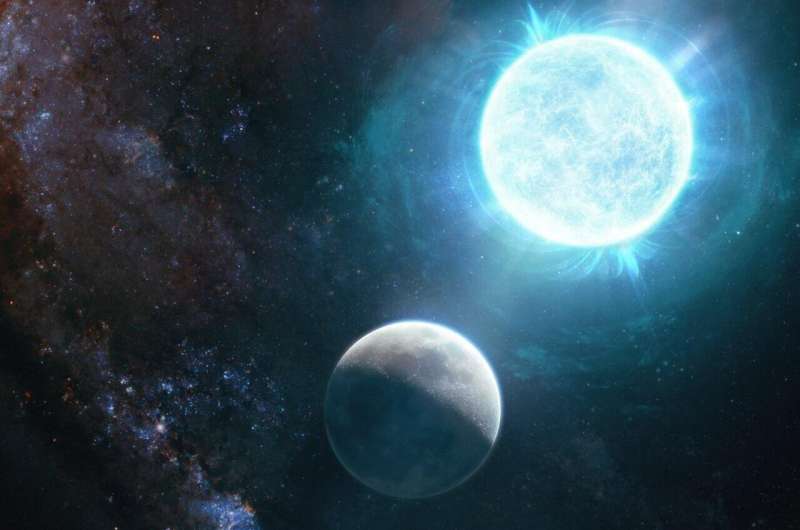
"This is highly speculative, but it's possible that the white dwarf is massive enough to further collapse into a neutron star," says Caiazzo. "It is so massive and dense that, in its core, electrons are being captured by protons in nuclei to form neutrons. Because the pressure from electrons pushes against the force of gravity, keeping the star intact, the core collapses when a large enough number of electrons are removed."
If this neutron star formation hypothesis is correct, it may mean that a significant portion of other neutron stars take shape in this way. The newfound object's close proximity (about 130 light-years away) and its young age (about 100 million years old or less) indicate that similar objects may occur more commonly in our galaxy.
Magnetic and fast
The white dwarf was first spotted by Caiazzo's colleague Kevin Burdge, a postdoctoral scholar at Caltech, after searching through all-sky images captured by ZTF. This particular white dwarf, when analyzed in combination with data from Gaia, stood out for being very massive and having a rapid rotation.
"No one has systematically been able to explore short-timescale astronomical phenomena on this kind of scale until now. The results of these efforts are stunning," says Burdge, who, in 2019, led the team that discovered a pair of white dwarfs zipping around each other every seven minutes.
The team then analyzed the spectrum of the star using Keck Observatory's Low Resolution Imaging Spectrometer (LRIS), and that is when Caiazzo was struck by the signatures of a very powerful magnetic field and realized that she and her team had found something "very special," as she says. The strength of the magnetic field together with the seven-minute rotational speed of the object indicated that it was the result of two smaller white dwarfs coalescing into one.
Data from Swift, which observes ultraviolet light, helped nail down the size and mass of the white dwarf. With a diameter of 2,670 miles, ZTF J1901+1458 secures the title for the smallest known white dwarf, edging out previous record holders, RE J0317-853 and WD 1832+089, which each have diameters of about 3,100 miles.
In the future, Caiazzo hopes to use ZTF to find more white dwarfs like this one, and, in general, to study the population as a whole. "There are so many questions to address, such as what is the rate of white dwarf mergers in the galaxy, and is it enough to explain the number of type Ia supernovae? How is a magnetic field generated in these powerful events, and why is there such diversity in magnetic field strengths among white dwarfs? Finding a large population of white dwarfs born from mergers will help us answer all these questions and more."
Explore further
Citation: A white dwarf living on the edge (2021, June 30) retrieved 30 June 2021 from https://ift.tt/3hfLdio
This document is subject to copyright. Apart from any fair dealing for the purpose of private study or research, no part may be reproduced without the written permission. The content is provided for information purposes only.
https://ift.tt/3hmp9Tf
Science
SpaceX launches 88 satellites in rideshare mission - CNN

https://ift.tt/3y4rfhg
Science
Celestial "Pac-Man": Astronomers spot massive black holes gobbling up city-sized neutron stars for the first time - CBS News
In what could be a considered a celestial version of "Pac-Man," scientists have detected black holes gobbling up neutron stars — marking the observation of collisions between the two most extreme objects in the universe for the very first time.
And the hefty feasts occurred one billion years ago.
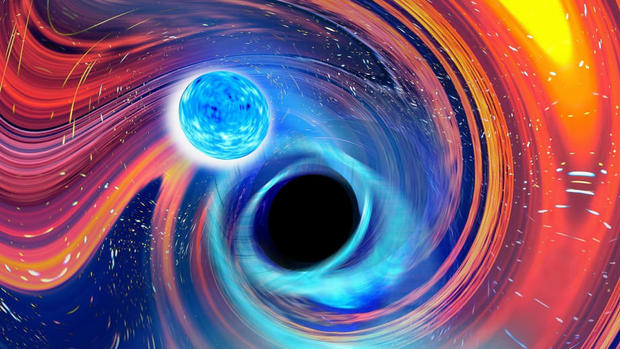
Within a 10-day time frame, a team of over 1,000 international scientists spotted the rare cosmic event twice using the Laser Interferometer Gravitational-Wave Observatory in the U.S. and the Virgo gravitational-wave observatory in Italy, They published their findings, originally documented in January 2020, on Tuesday in The Astrophysical Journal Letters.
While researchers have suspected this type of event in the past, this is the first time one has been confirmed. Ecstatic researchers say the observations of the death spiral and merger of neutron stars and black holes will help "unlock some of the most complex mysteries of the universe," including the building blocks of matter and the nature of the space-time continuum.
Co-author Susan Scott said that, although the collisions occurred about a billion years ago, they were so massive that their gravitational waves — ripples in space-time that shake the entire universe — have only just finished traveling at least 900 million light years to reach Earth.
"These collisions have shaken the universe to its core and we've detected the ripples they have sent hurtling through the cosmos," she said in a statement Wednesday. "Each collision isn't just the coming together of two massive and dense objects. It's really like Pac-Man, with a black hole swallowing its companion neutron star whole."
Ahead of the collision and merger, the two massive objects, both the corpses of massive dead stars, orbit each other at around half the speed of light. During the newly-captured collision, the neutron star is warped and deformed as it nears the black hole, which becomes more massive as it swallows the star whole.
In one instance, a black hole with a mass nine times that of our sun swallowed up a neutron star with a mass around twice that of the sun. The other event involved a black hole with a mass about six times bigger than the sun snacking on a neutron star about 1.5 times the sun's mass.
All of the mass of a neutron star is squeezed into an extremely dense star, which is about the size of a city. Scientists say that one teaspoon of a neutron star weighs as much as all of humanity.

Astronomers searched the sky for flashes of light that may have resulted from the events, but none were found, possibly due to their distance from Earth. Additionally, the black holes in these cases were large enough to swallow the entirety of the neutron stars, leaving behind no light to detect.
"These were not events where the black holes munched on the neutron stars like the cookie monster and flung bits and pieces about," said co-author Patrick Brady. "That 'flinging about' is what would produce light, and we don't think that happened in these cases."
Scientists have previously captured two black holes smashing together and the collision of two neutron stars — but they "have waiting a very long time" to witness the two come together.
"Now, we've completed the last piece of the puzzle with the first confirmed observations of gravitational waves from a black hole and a neutron star colliding," Scott said.
Astronomers have spent decades hunting for this sort of event in the Milky Way galaxy, but have yet to find any.
"With this new discovery of neutron star-black hole mergers outside our galaxy, we have found the missing type of binary," co-author Astrid Lamberts said. "We can finally begin to understand how many of these systems exist, how often they merge, and why we have not yet seen examples in the Milky Way."
"These kind of detections are incredibly rare," said co-author Johannes Eichholz. "We haven't detected these events once — but twice and within 10 days of each other. "Like the ripples from these two events, which have been felt a billion years later, these findings will have a profound impact on our understanding of the universe for many years to come."
Article From & Read More ( Celestial "Pac-Man": Astronomers spot massive black holes gobbling up city-sized neutron stars for the first time - CBS News )https://ift.tt/3Ah4usf
Science
'Extreme' white dwarf sets cosmic records for small size, huge mass - Yahoo News
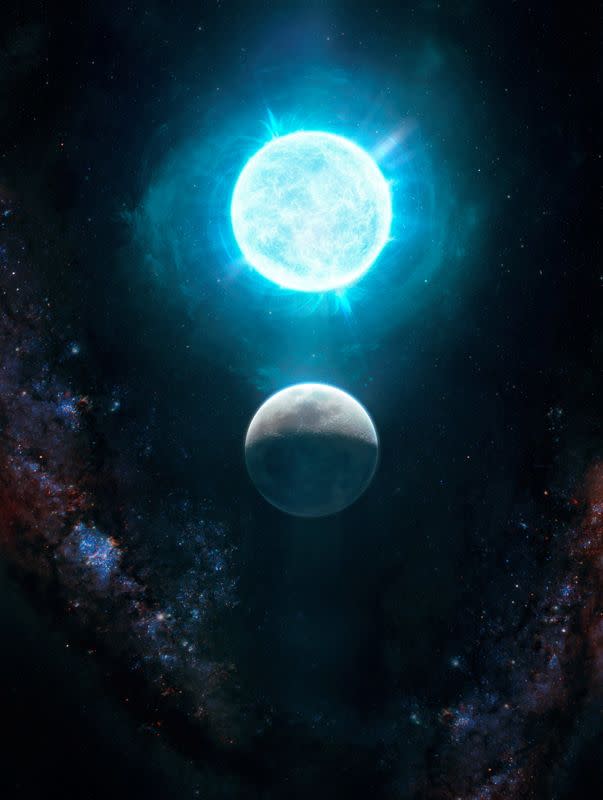
By Will Dunham
WASHINGTON (Reuters) - In their death throes, roughly 97% of all stars become a smoldering stellar zombie called a white dwarf, one of the densest objects in the cosmos. A newly discovered white dwarf is being hailed as the most "extreme" one of these on record, cramming a frightful amount of mass into a surprisingly small package.
Scientists said on Wednesday this highly magnetized and rapidly rotating white dwarf is 35% more massive than our sun yet boasts a petite diameter only a bit larger than Earth's moon. That means it has the greatest mass and, counterintuitively, littlest size of any known white dwarf, owing to its tremendous density.
Only two other types of objects - black holes and neutron stars - are more compact than white dwarfs.
The way this white dwarf, named ZTF J1901+1458, was born also is unusual. It apparently is the product of a binary star system in which two stars orbit each other. These two stars separately evolved into white dwarfs at the end of their life cycles, then spiraled toward one another and merged into a single entity.
With even a smidgen more combined mass, this merger would have resulted in an immense stellar explosion called a supernova, said Caltech astrophysicist Ilaria Caiazzo, lead author of the study published in the journal Nature. It still might explode at some point in the future, Caiazzo added.
"This white dwarf is really extreme," Caiazzo said. "We found an object that is really at the limit of how small and heavy a white dwarf could be."
It is located relatively nearby in our Milky Way galaxy, about 130 light years from Earth. A light year is the distance light travels in a year - about 5.9 trillion miles (9.5 trillion km).
The white dwarf is actually shrinking very gradually, becoming ever more dense. If it does not explode, that could lead to a core collapse transforming it into a neutron star, another type of stellar remnant about the size of a city, typically formed after certain very massive stars go supernova. This would be a previously unrecognized path to neutron star formation.
The white dwarf was spotted by astrophysicist and study co-author Kevin Burdge from Caltech's Palomar Observatory.
"White dwarfs are the most common form of stellar remnant," said Burdge, who worked on the study at Caltech and is headed to MIT. "So it's stunning to see the most extreme outliers among them."
Its diameter of roughly 2,670 miles (4,300 km) - approximately the distance from Boston to Los Angeles or London to Tehran - slightly exceeds the moon's diameter of about 2,160 miles (3,475 km).
While our sun rotates around its axis once every 27 days, this white dwarf does so every seven minutes. Its magnetic field is about a billion times stronger than Earth's.
Stars with up to eight times the mass of our sun are thought to be destined to end up as a white dwarf. Such stars eventually burn up all of the hydrogen they use as fuel through nuclear fusion. At this point, gravity causes them to collapse and blow off their outer layers in a 'red giant' stage, eventually leaving a dense core that is a white dwarf.
White dwarfs initially have high temperatures but gradually cool over time, lacking any new energy source. In roughly 5 billion years, our sun is expected to become a red giant and later a white dwarf.
(Reporting by Will Dunham, Editing by Rosalba O'Brien)
Article From & Read More ( 'Extreme' white dwarf sets cosmic records for small size, huge mass - Yahoo News )https://ift.tt/3w9UduG
Science
LIVE: SpaceX launches Transporter 2 mission - Reuters
https://ift.tt/3h9sPsO
Science
Dinosaurs were already struggling before the asteroid strike that doomed them to extinction, study finds - CNN
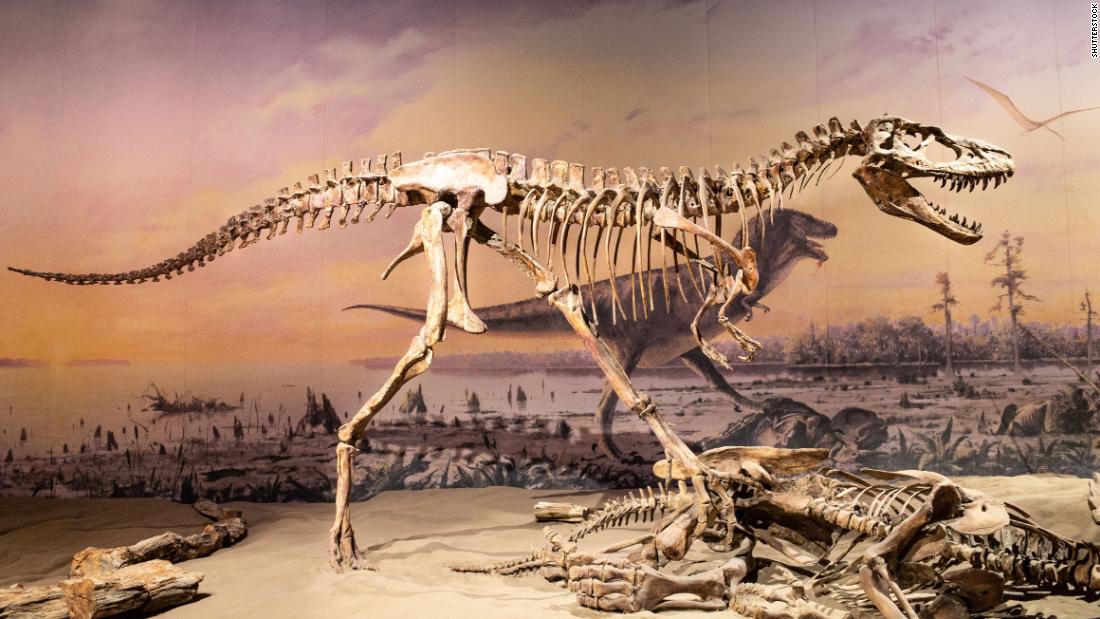
https://ift.tt/3y9zV65
Science
NASA Curiosity rover may have solved Mars methane mystery - CNET
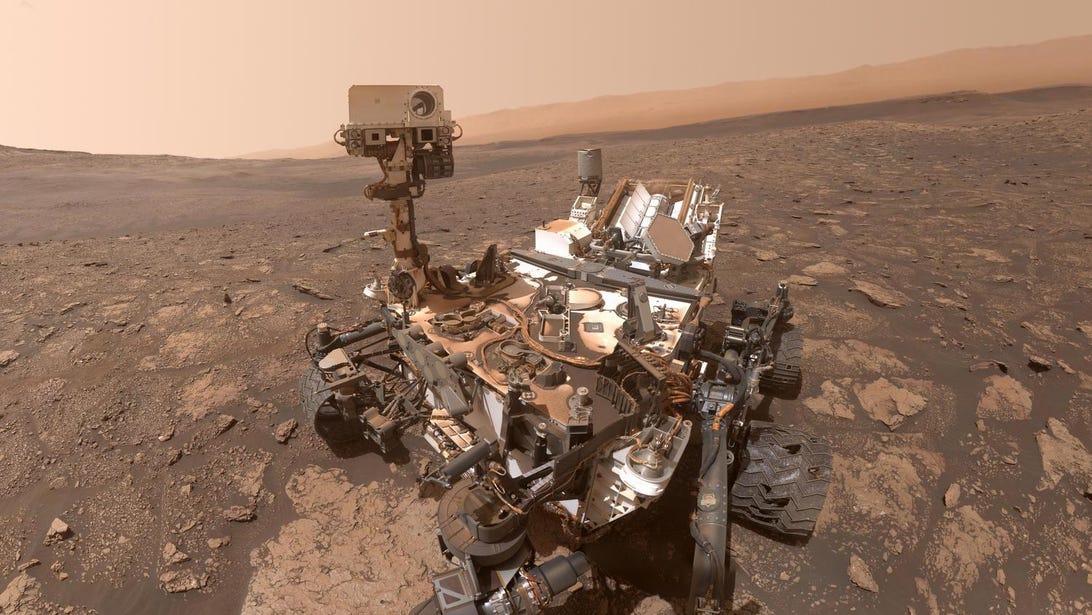
NASA's Curiosity rover snapped this selfie in 2020.
NASA/JPL-Caltech/MSSSMethane. On Earth, it's the stuff of cow farts and burps. On Mars, it's the stuff of mysteries. Scientists have been puzzling over methane readings from Mars, and NASA may be a step closer to figuring out what's going on with the gas on the red planet. It turns out the time of day has a big impact on methane detections.
Methane is particularly intriguing because it can be a byproduct of living things, including microbes. Researchers are trying to work out if Mars once hosted microbial life, or if microbes might possibly survive there now. But don't get too hyped; methane can also have a geologic origin.
What's weird about methane on the red planet is that NASA's Curiosity rover has detected the gas near the surface in the Gale Crater, but the European Space Agency's ExoMars Trace Gas Orbiter spacecraft isn't seeing methane higher up in the atmosphere. So what's going on?
Curiosity's Tunable Laser Spectrometer instrument is part of its Sample Analysis at Mars system, essentially a portable chemistry lab. Usually, TLS detects a small amount of methane NASA describes as "equivalent to about a pinch of salt diluted in an Olympic-size swimming pool." In 2019, TLS notably detected a considerable spike in methane levels.
The ExoMars orbiter, which arrived at Mars in 2016, hasn't been seeing what Curiosity sees. "But when the European team announced that it saw no methane, I was definitely shocked," TLS instrument lead Chris Webster said in a NASA statement on Tuesday.
Mars pits: Gaze into the abyss with these wild NASA images
See all photosThe discrepancy may come down to the times of day when the orbiter and rover work. The power-hungry TLS on the rover operates at night so it doesn't conflict with other instruments. The orbiter makes its detections during the day when it has sunlight to help it. What may be happening is that methane pools near the surface during calm nights and dissipates during the day, making it invisible to the spacecraft.
The Curiosity team tested this idea by taking daytime methane measurements, and indeed the gas disappeared during the day. The researchers published their findings today in the Astronomy and Astrophysics journal (PDF link).
While one methane mystery may have an explanation, another gassy conundrum lingers. NASA is still trying to sort out the "global methane puzzle at Mars." Methane released from Mars craters should remain stable enough -- and accumulate in the atmosphere enough -- for detection by the Trace Gas Orbiter.
Scientists are now looking into what might be destroying the methane. "We need to determine whether there's a faster destruction mechanism than normal to fully reconcile the data sets from the rover and the orbiter," said Webster. Until then, Mars methane will remain an enigma.
Follow CNET's 2021 Space Calendar to stay up to date with all the latest space news this year. You can even add it to your own Google Calendar.
Article From & Read More ( NASA Curiosity rover may have solved Mars methane mystery - CNET )https://ift.tt/367eGFS
Science
Falcon 9 launch scrub highlights airspace integration problems - SpaceNews
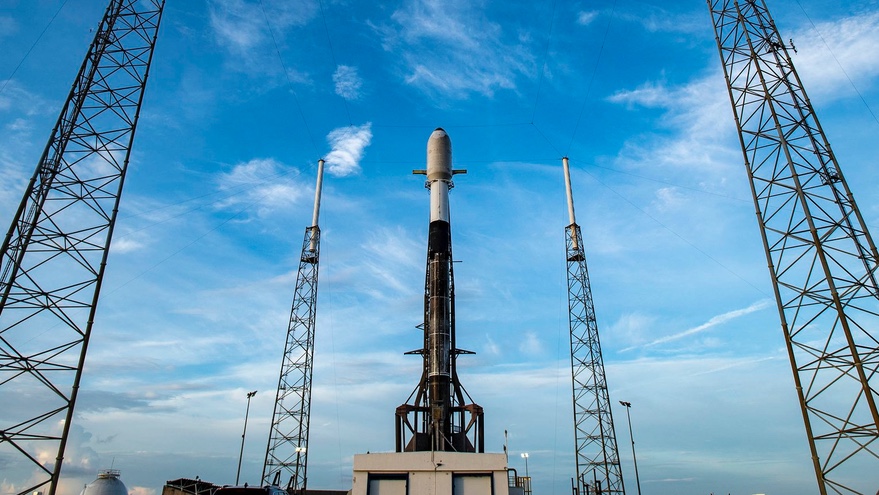
WASHINGTON — A SpaceX launch scrubbed in the final seconds of its countdown when an aircraft violated restricted airspace June 29 has aligned both the launch industry and the airline industry in their criticism of the Federal Aviation Administration.
SpaceX was preparing to launch a Falcon 9 from Cape Canaveral Space Force Station in Florida at 2:56 p.m. Eastern. The Transporter-2 mission is carrying 88 satellites on SpaceX’s second dedicated smallsat rideshare missions, supporting customers ranging from NASA and the Pentagon’s Space Development Agency to several companies developing remote sensing and communications constellations.
However, the countdown was stopped 11 seconds before liftoff because of a “fouled range,” or range violation of some kind. While SpaceX had nearly a one-hour launch window for this mission, the company scrubbed the launch minutes later because it would not have time to prepare the vehicle for another launch attempt. The launch has been tentatively rescheduled for the same time June 30.
SpaceX did not disclose what caused the range violation and subsequent scrub, although the host of the company’s webcast speculated it could be an aircraft. Elon Musk, founder and chief executive of SpaceX, confirmed that in a tweet minutes after the scrub.
“Unfortunately, launch is called off for today, as an aircraft entered the ‘keep out zone’, which is unreasonably gigantic,” he wrote. “There is simply no way that humanity can become a spacefaring civilization without major regulatory reform. The current regulatory system is broken.”
Musk has expressed similar criticisms of the FAA’s “broken” regulatory system in the past, but that focused on the launch licensing process rather than airspace restrictions. Musk’s latest criticism mirrors that from the commercial aviation industry, which for years has complained that the size and duration of airspace restrictions for launches cause flight delays and disrupt airline schedules.
The issue came up most recently at a June 16 hearing of the House Transportation Committee’s aviation subcommittee, which revisited several issues regarding the FAA’s oversight of commercial space transportation.
“FAA has also made progress in developing procedures, technologies and industry coordinations to reduce inefficiencies in safely integrating commercial space users into the National Airspace System,” said Heather Krause, director of physical infrastructure at the Government Accountability Office, in testimony at the hearing. “These efforts are promising, but full and efficient integration of all users of the National Airspace System is years away and will require continued work and focus.”
Rep. Rick Larsen (D-Wash.), chair of the subcommittee, asked if the FAA was making sufficient progress toward that goal. Krause responded that the FAA had taken “a number of steps” since a 2019 review that highlighted inefficiencies. “It is a complex issue to work through, and technologies and systems need to be further developed so that there’s better data to be able to assess risk.”
Rep. Peter DeFazio (D-Ore.), chair of the full committee, criticized the FAA for slow progress in one specific tool, called the Space Data Integrator, which is intended to provide information on launch activities more quickly to air traffic controllers and pilots, reducing the size and duration of airspace restrictions. He asked Wayne Monteith, FAA associate administrator for commercial space transportation, about the timeline for development of the tool, noting it had been discussed at a hearing five years ago.
Monteith responded that progress had accelerated on the Space Data Integrator since the project was handed over to Teri Bristol, chief operating officer of the FAA’s Air Traffic Organization. “We expect in the next few months to have the first operational tests of it,” he said. “We will be taking live data and ingesting it into our system with the goal of reducing the airspace that must be segregated and really integrate commercial space into the system,” he said.
One of the critics of current approaches to restrict airspace for launches has been the Air Line Pilots Association (ALPA). At the hearing, Capt. Joe Depete, president of ALPA, called for “collaboration by the aviation and aerospace sectors” to develop an airspace integration strategy.
“We agree that there is a better way,” DePete tweeted in response to Musk after the launch scrub, offering to work with SpaceX, the FAA and others “to support the safe integration of all national airspace users.”
Article From & Read More ( Falcon 9 launch scrub highlights airspace integration problems - SpaceNews )https://ift.tt/3y6ZN2r
Science
Russia's Progress cargo ship successfully launches to space station - Space.com
Tonight (June 29), Russia's uncrewed Progress 78 mission successfully launched to space.
At 7:27 p.m. EDT (2327 GMT, or 4:27 a.m. June 30 local time, Russia's Progress MS-17 cargo spacecraft launched to the International Space Station from the Russian space agency Roscosmos' Baikonur Cosmodrome in Kazakhstan in a mission dubbed Progress 78 by NASA. The cargo ship launched aboard a Soyuz 2.1a rocket.
After lifting off to space, the spacecraft will spend two days in orbit before docking with the space station on July 1 at 9:02 p.m. EDT (July 2 at 0102 GMT). The vehicle carries more than 3,600 lbs. (1,633 kilograms) of cargo including food, fuel and supplies to the orbiting lab.
Video: Watch Russia's Progress 77 cargo ship blast off
Related: How Russia's Progress cargo ships work (infographic)

After arriving at the space station, the spacecraft will dock with the station's Poisk module, located on the station's Russian segment, where it will spend the next five months.
After this leg of its mission, in October, the Progress capsule is set to perform an automated undocking and relocation to Russia's upcoming "Nauka" Multipurpose Laboratory Module that is scheduled to launch to space this upcoming July. Nauka is named for the Russian word for "science."
After a short stint at Nauka, the spacecraft will undock from the space station in November. It will then reenter Earth's atmosphere, where it will burn up over the Pacific Ocean as part of a planned and safe destruction, according to a NASA statement.
While Russia refers to the spacecraft as Progress MS-17, the mission is described by NASA as Progress 78 or 78P because it is Russia's 78th Progress mission to the International Space Station. However, other Progress supply missions preceded these, with older versions of the craft flying to previous space stations as early as 1978. In fact, while this was the 78th Progress launch to the ISS, it is actually the 169th flight of a Progress vehicle.
Email Chelsea Gohd at cgohd@space.com or follow her on Twitter @chelsea_gohd. Follow us on Twitter @Spacedotcom and on Facebook.
Article From & Read More ( Russia's Progress cargo ship successfully launches to space station - Space.com )https://ift.tt/2TdRrYg
Science
Tuesday, June 29, 2021
Elon Musk calls rocket launch regulations 'broken' after aircraft delays SpaceX launch - CNBC
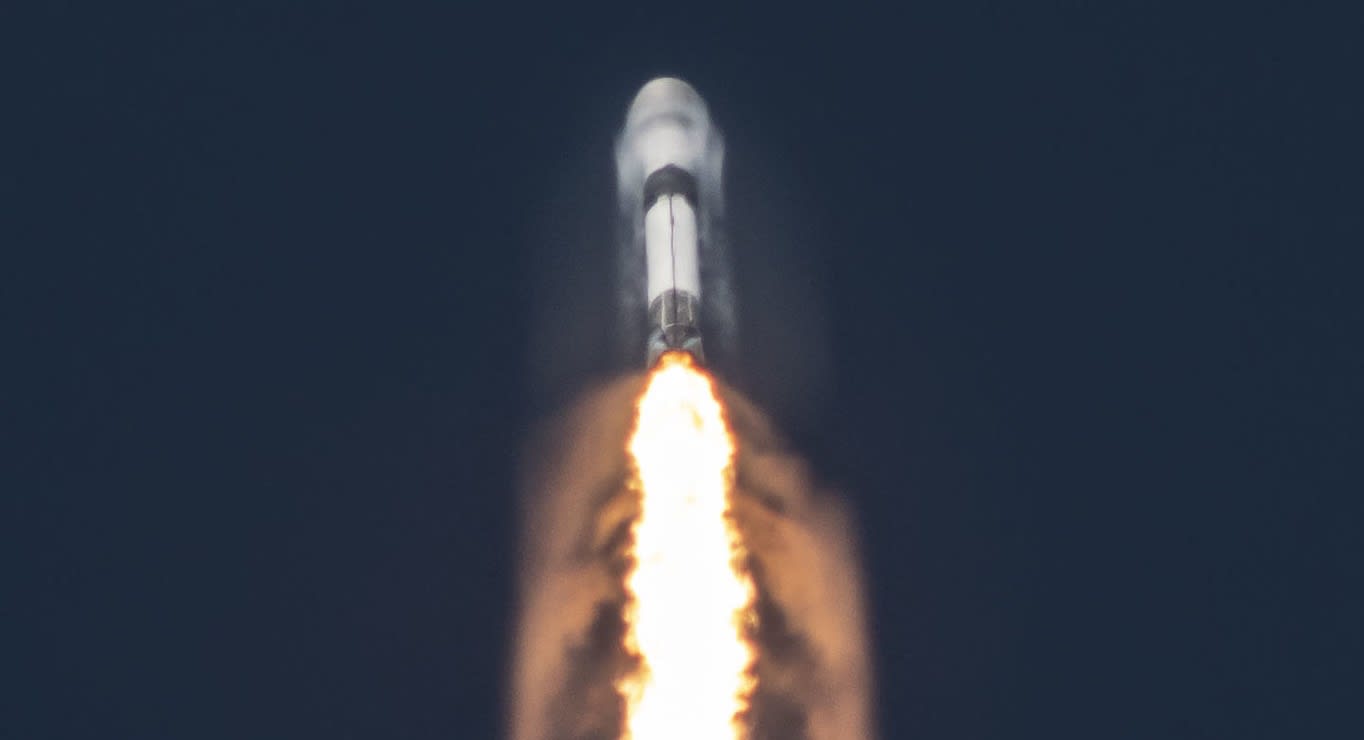
SpaceX was seconds away from launching its 20th mission of this year Tuesday when the countdown was halted due to an aircraft entering the launch range, delaying the mission by at least a day.
Elon Musk took to Twitter to voice his frustration about the delay, reiterating prior criticisms he has made about regulations around the business of launching rockets.
"An aircraft entered the 'keep out zone', which is unreasonably gigantic," Musk wrote in a tweet.
"There is simply no way that humanity can become a spacefaring civilization without major regulatory reform. The current regulatory system is broken," he added.
Musk has ratcheted up his criticism of launch regulations this year, with SpaceX firing off Falcon 9 rockets at a blistering pace – with launches going up an average of every nine days – and also flying multiple development tests of its Starship prototype rockets. After a Starship test was delayed in January, Musk similarly criticized the Federal Aviation Administration for how it handles launch regulations.
"Unlike its aircraft division, which is fine, the FAA space division has a fundamentally broken regulatory structure," Musk wrote then. "Their rules are meant for a handful of expendable launches per year from a few government facilities. Under those rules, humanity will never get to Mars."
The FAA has internally pushed back on SpaceX, after the company violated its launch license with the authorized test flight of Starship prototype SN8 in December. Since then, the FAA says SpaceX has "modified their procedures effectively" and earlier this month testified before Congress about efforts to streamline launch regulations and rules.
Although he's publicly criticized regulators, Musk has also stated that "99.9% of the time, I agree with regulators!"
"On rare occasions, we disagree. This is almost always due to new technologies that past regulations didn't anticipate," Musk said in April.
Become a smarter investor with CNBC Pro.
Get stock picks, analyst calls, exclusive interviews and access to CNBC TV.
Sign up to start a free trial today.
https://ift.tt/3h6TiqV
Science
Scientists say there's no life on Venus — but Jupiter has potential - CBS News
It turns out the clouds of Venus aren't made of the right stuff to support life — so now, scientists are turning to Jupiter instead.
Hellish temperatures on the surface of Venus can reach nearly 900 degrees Fahrenheit — creating a less-than-hospitable planet. But a study last year renewed hopes that Venus could support life after researchers detected phosphine gas, which is produced by bacteria on Earth, in its more temperate clouds.
Now, a new study published Monday in the journal Nature Astronomy, found that the water concentration in our nearest neighbor's infamous sulphuric acid clouds is just too dry for life as we know it to find a way to survive.
Microbiologist John Hallsworth discovered a terrestrial fungus in 2017 that is capable of surviving at 58.5% relative humidity — the driest conditions a living creature has ever withstood. He decided to test whether they could exist on other planets.
"We bent over backwards to argue that the most extreme, tolerant microbes on Earth could potentially have activity on Venus," Hallsworth said at a press conference.
Hallsworth found no known living organism could survive our sister planet's atmosphere, which is equivalent to a relative humidity of 0.4%. His team studied the planet's "water activity," meaning its concentration of water molecules, rather than the actual quantity of water, to come to their conclusion.
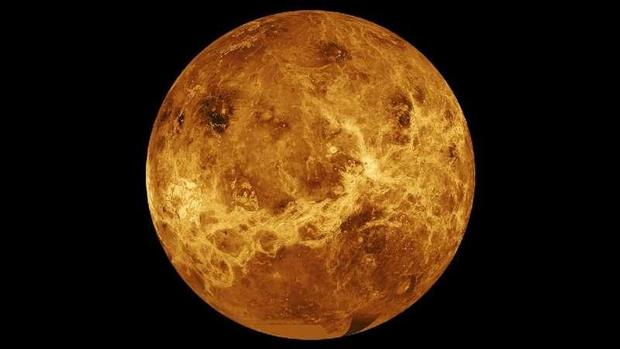
Water activity is calculated based on direct observations of pressure, temperature and water concentration. Researchers used existing measurements from seven U.S. and Soviet probes and one orbiter mission from the late 1970s and early 1980s.
"It's more than 100 times too low," he said. "It's almost at the bottom of the scale, at an unbridgeable distance from what life requires to be active."
"The search for extraterrestrial life has sometimes been a bit simplistic in its attitude to water," said co-author Philip Ball. "As our work shows, it's not enough to say that liquid water equates with habitability. We've got to think too about how Earth-like organisms actually use it – which shows us that we then have to ask how much of the water is actually available for those biological uses."
The findings come nearly a month after NASA announced two new discovery missions to the inferno-like planet, scheduled to launch between 2028 and 2030. One of those missions could help determine if Venus could have supported life billions of years ago.
"One of the missions will fly through the atmosphere and measure trace gases... which will tell us a lot about Venus's evolutionary history and will start to address questions like how much atmosphere did Venus have, where did it go, what happened?" McKay said.
Could Jupiter support life?
Scientists may have ruled out alien life on Venus, but Jupiter still holds promise.
Studying probes that visited other planets, researchers found that Jupiter's clouds have a high enough concentration of water, and a viable temperature, for life to exist — assuming other requirements, like nutrients, are also present.
"The results were much more optimistic," said co-author Chris McKay. "There is at least a layer in the clouds of Jupiter where the water requirements are met."

But it's a lot easier to rule out alien life on Venus than to prove it's possible on Jupiter.
"To show that that layer is habitable we would have to go through all the requirements for life and show that they're all met," McKay said.
He added that further exploration is needed to determine other factors, like ultraviolet exposure and energy sources. But the research does provide a promising basis to study all other planets in the future.
"We have also performed calculations for Mars and Earth and show that these calculations can be done for planets outside our solar system," Hallsworth said. "While our research doesn't claim that alien (microbial-type) life does exist on other planets in our solar system, it shows that if the water activity and other conditions are right, then such life could exist in places where we haven't previously been looking."
Article From & Read More ( Scientists say there's no life on Venus — but Jupiter has potential - CBS News )https://ift.tt/363d0NG
Science
Astronomers detect black holes swallowing up neutron stars for the first time - CNET
On Jan. 5, 2020, astrophysicists heard a chirp from a distant part of the cosmos, some 900 million light-years away. The fleeting sound was unlike any they'd heard before and was caused by a great ripple in space-time -- a gravitational wave -- that spread out across the universe from over 900 million light-years away, washing over the Earth and pinging detectors. Chirp.
Then, 10 days later, they heard another, similar sound. A cosmic twin. Gravitational waves had once again pinged Earth's detectors. Chirp.
After careful analysis, the two signals have been identified as emanating from extreme, never-before-seen events in deep space: the collision between a black hole and a neutron star.
The pair of collisions (or, less poetically, "mergers") are detailed in a new study published in the Astrophysical Journal Letters on Tuesday, featuring over 1,000 scientists from the LIGO/Virgo and KAGRA collaborations, a multinational effort to hunt for gravitational waves. The two newly described events are named GW200105 and GW200115, for the dates they were discovered, and provide the first definitive evidence of an elusive merger.
Prior to the dual detection, astronomers had only found black holes merging with black holes and neutron stars merging with neutron stars.
"We've been waiting and expecting, at some stage, to detect a system with one of each," said Susan Scott, an astrophysicist at Australian National University and a member of OzGrav and the LIGO collaboration.
Now they have.
Over the last two years, there had been suggestions that a collision between a neutron star and a black hole may have been spotted -- but one of the objects appeared a little unusual. It was too big to be a neutron star and too small to be a black hole. The unknown object remains a mystery, which means GW200105 and GW200115 will go down in history.
"These are the first really confident detections of the merger of a neutron star with a black hole," adds Rory Smith, an astrophysicist at Monash University in Australia and a member of the LIGO collaboration.
Chirpy
A quick interlude before we continue.
Black holes and neutron stars are strange objects. They are the relics of dead stars and form at the end of a star's life. The size of a star affects how its life comes to a close. If it's a small star (small being "about 10 times more massive than our sun"), it collapses into an incredibly dense "zombie star," known as a neutron star. If it's a big star, it collapses into a black hole. Both are well-known and well-studied objects, but they still contain many mysteries.
For one, we can't see inside them. This is a much-discussed trait of black holes. Their gravity is so strong that when light gets pulled in -- past the so-called event horizon -- it never comes back out. But scientists also don't know what is going on in the heart of a neutron star. They suspect some truly weird physics could be occurring within both objects. The laws of physics seem to break down inside them.
Observing the objects via gravitational waves is a "kind of stellar paleontology," according to Smith, because it can tell us about their evolutionary history and the environments they form in.
The chirps are central to this. When US-based LIGO and Italy-based Virgo detect a "chirp," they are looking back through time. Within the chirp is a bunch of information that can tell astrophysicists how massive the colliding objects are and the way they spin. This information is critical to understanding how the two objects came to be locked in a death dance with each other.
"By studying these systems, we get to know a lot more about the life and death of black holes and neutron stars in these binary systems," Scott said.
Star stuff
GW200105, the chirp detected on Jan. 5, 2020, and GW200115, the chirp detected on Jan. 15, 2020, are similar events but the objects that collided have slightly different properties. Those stuffy scientific names are rather confusing, so we've dubbed them Lenny (GW200105) and Carl (GW200115).
The researchers say that Lenny is the result of a black hole about nine times as massive as the sun colliding with a neutron star about 1.9 times as massive as the sun. Carl came via a black hole about six times as massive as the sun merging with a neutron star about 1.5 times as massive as the sun. Lenny and Carl are completely different beasts in the present day. The mergers occurred almost a billion years ago far from the Earth, and the chirps only recently reached us.
When we say "collide" or "merge" here, we're not entirely sure what happened when the two objects finally came together. For a long time, they circled each other, trapped by the other's gravity. Eventually, they came together. Scott describes Lenny and Carl as "a bit like Pac-Man," with the black hole swallowing up the neutron star.
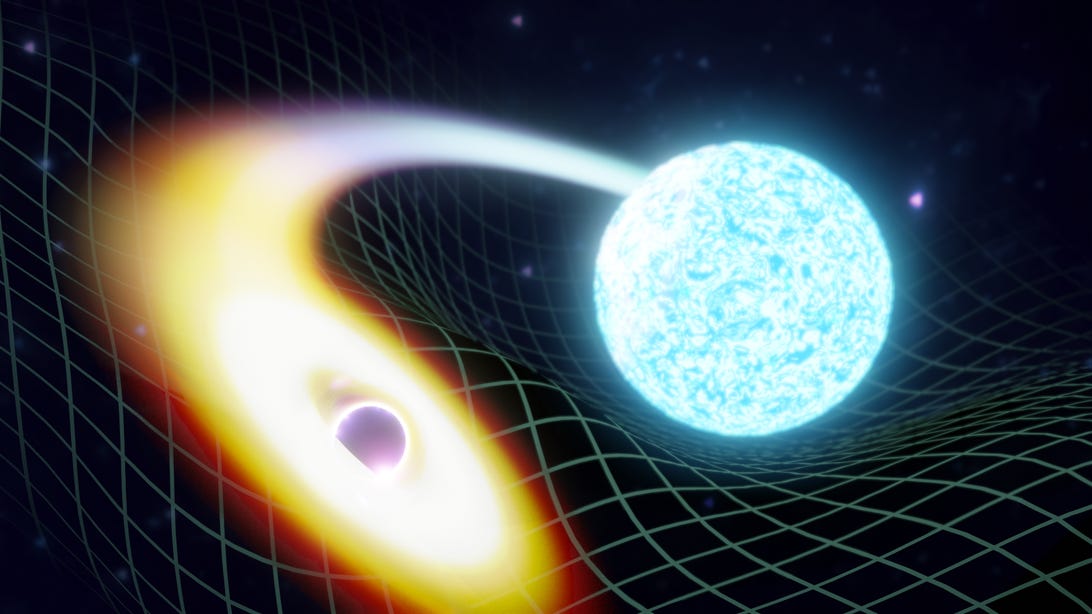
Another artistic rendition of a black hole and neutron star merger with the black hole stealing material from its counterpart.
LIGO-India/Soheb MandhaiThere's also the possibility the black hole "shreds" the neutron star in a process known as tidal disruption. In this scenario, the black hole would rip material from the surface of the neutron star and steal it, creating a disk of debris around the event horizon. "That should produce an electromagnetic signal," Scott said.
And a shredded neutron star is a goldmine for astrophysicists. You can't make the material present in a neutron star in a laboratory and study it, so these types of events may open a window to understand what's happening inside them.
"By watching how a neutron star is pulled apart by a black hole, we are beginning to learn about how matter behaves in its most dense state," said Eric Thrane, an astrophysicist at Monash University and member of the LIGO collaboration. With enough gravitational wave detections, we may be able to decode their properties.
That makes Lenny and Carl the first of many black hole-neutron star mergers helping shed light on the most extreme objects in our universe.
"These observations may one day reveal new laws of nature," Smith said.
Article From & Read More ( Astronomers detect black holes swallowing up neutron stars for the first time - CNET )https://ift.tt/2Tdchac
Science
After delayed SpaceX launch, Musk says reform needed for humanity to 'become a spacefaring civilization' - Fox Business
Window opens for a SpaceX Falcon 9 carrying the GPS III Space Vehicle 05 mission
SpaceX was seconds away from sending dozens of satellites into orbit aboard its Falcon 9 rocket on Tuesday when the launch was called off because an airplane entered its launch zone.
The launch's 24-hour delay earned the ire of SpaceX CEO Elon Musk, who tweeted that the rocket's "keep out zone" is "unreasonably gigantic."
"There is simply no way that humanity can become a spacefaring civilization without major regulatory reform," Musk tweeted minutes after the delay. "The current regulatory system is broken."
RICHARD BRANSON PUSHING FOR SPACE TRIP BEFORE AMAZON'S BEZOS: REPORT
It's the latest in a long-running feud between Musk and regulators. In December, the Federal Aviation Administration says that SpaceX ignored several warnings from the agency when it launched its Starship SN8, which it hopes will one day take humans to Mars.
The FAA told FOX Business earlier this month that SpaceX sought a waiver to "exceed the maximum public risk allowed by federal safety regulations," but was denied the request.

A SpaceX Falcon 9 rocket with the Crew Dragon space capsule leaves a trail of smoke as it lifts off from pad 39A at the Kennedy Space Center in Cape Canaveral, Fla., Friday, April 23, 2021. (AP Photo/John Raoux)
Musk said in January that the "FAA space division has a fundamentally broken regulatory structure."
"Their rules are meant for a handful of expendable launches per year from a few government facilities," Musk tweeted on Jan. 28. "Under those rules, humanity will never get to Mars."
NASA ‘KEEPING EYE’ ON JEFF BEZOS AND OTHER SPACE ASTRONAUT BILLIONAIRES
It's not just the FAA that Musk has gotten into testy exchanges with. He hung up on the head of the National Transportation Safety Board in 2018 during a phone call about a fatal car crash involving a Tesla Model X, Bloomberg reported. And he infamously got into hot water with the Securities and Exchange Commission that same year when he tweeted about taking Tesla private.
Despite the run-ins with regulators, Musk tweeted in April that he agrees with them "99.9% of the time."
"On rare occasions, we disagree," Musk tweeted on April 27. "This is almost always due to new technologies that past regulations didn’t anticipate."
CLICK HERE TO READ MORE ON FOX BUSINESS
After the delay, SpaceX is planning to launch the Falcon 9 rocket Wednesday afternoon from Cape Canaveral Space Force Station in Florida.
The rocket will take 88 satellites into space for a mix of private companies and government entities, including three satellites for Starlink, which the company hopes will provide high-speed internet to the world.
Fox News's Julia Musto contributed to this report.
Article From & Read More ( After delayed SpaceX launch, Musk says reform needed for humanity to 'become a spacefaring civilization' - Fox Business )https://ift.tt/3hmoMrF
Science
Search
Featured Post
SpaceX to launch 23 Starlink satellites from Florida tonight - Space.com
SpaceX plans to launch 23 more of its Starlink satellites tonight (May 12), adding to its huge and ever-growing broadband megaconstellation...

Postingan Populer
-
Tech giant Google ( GOOG , GOOGL ) on Thursday announced it will spend $7 billion this year on an expansion of its U.S. facility footprint,...
-
China’s Zhurong rover landed safely on Mars on May 15 , making China only the third country to successfully land a rover on the red planet....
-
Every year, millions of monarch butterflies fly up to 3,000 miles from southern Canada and the upper reaches of the United States to their...